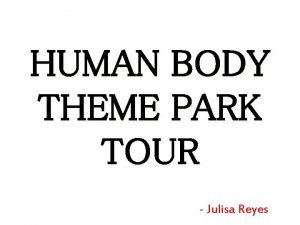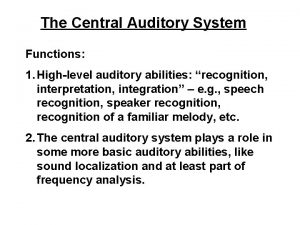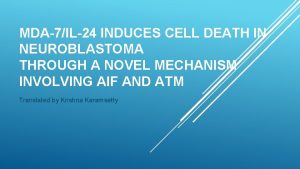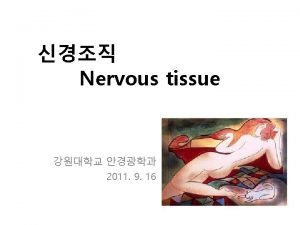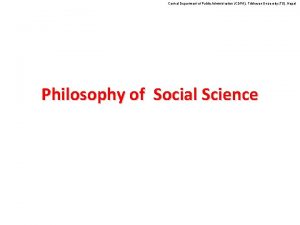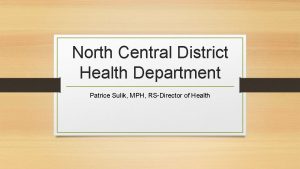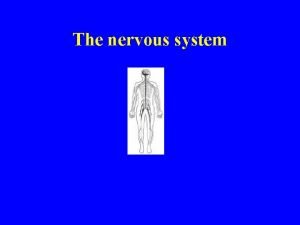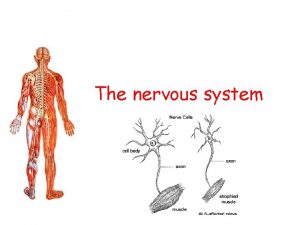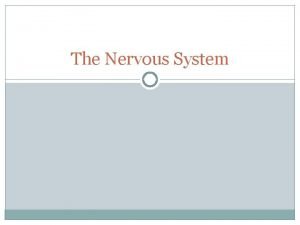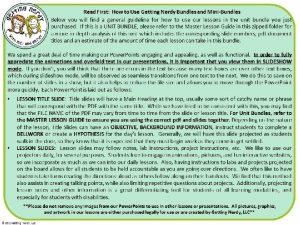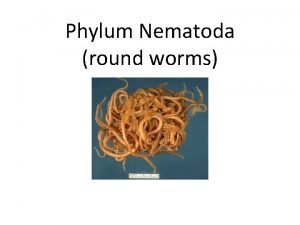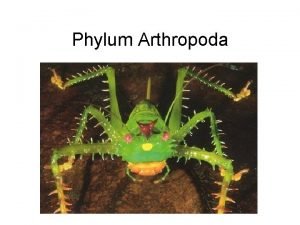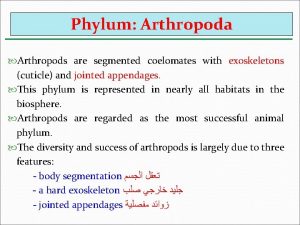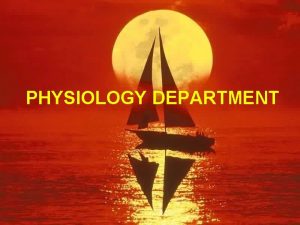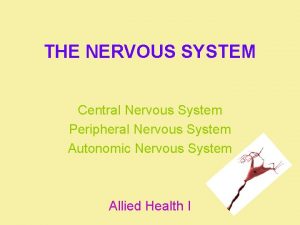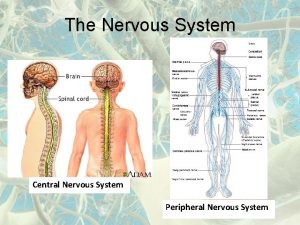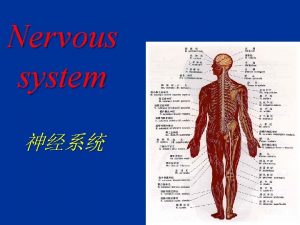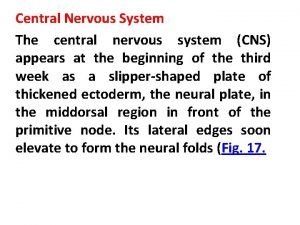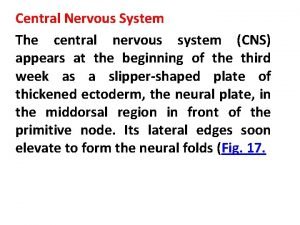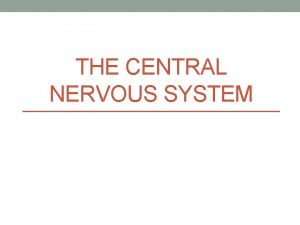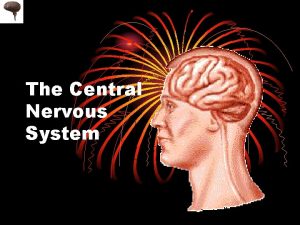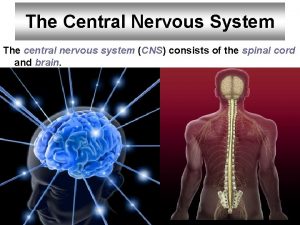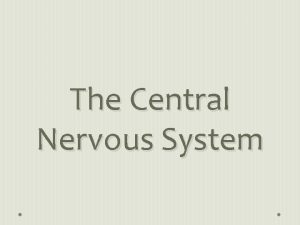PHYSIOLOGY DEPARTMENT CENTRAL NERVOUS SYSTEM PHYSIOLOGY LECTURE 1






































- Slides: 38

PHYSIOLOGY DEPARTMENT

CENTRAL NERVOUS SYSTEM PHYSIOLOGY. LECTURE #1. SPINAL CORD PHYSIOLOGY OF MEDULLA OBLONGATA AND MIDBRAIN Ass. Prof. VASTYANOV Rooslan

ATTENTION !!!

SPINAL CORD PHYSIOLOGY

SPINAL CORD COMPOSITION The law of Bell - Mazhandi The ventral roots have motor (efferent) fibers whereas the spinal cord dorsal roots have sensitive (afferent) fibers.


Spinal Cord Cross-section

Spinal Cord Neurones Motor neurons Alpha-motor neurons, HT Alpha-motor neurons, LT Gamma-motor neurons Sensitive neurons are located in the back horns


Spinal Cord Functions REFLECTORY CONDUCTIVE

Spinal Cord Reflexes 1. Stretch reflex (phasic) 2. Withdrawal reflex (tonic) 3. Reflex of muscle-antagonists 4. Viscero-motor reflexes 5. Vegetative reflexes.

Stretch reflex (knee reflex) scheme

Withdrawal reflex scheme

Muscle – antagonists reflex scheme

Spinal Cord Functions REFLECTORY CONDUCTIVE

Spinal Cord Cross-Section. The view of the conductive pathways.

The uscendent pathways of the spinal cord 1 Tractus spino-thalamicus lateralis Tractus spino-thalamicus ventralis 2 Tractus spino-cerebellaris dorsalis Tractus spino-thalamicus ventralis 3

The descendent pathways of the spinal cord Tractus cortico-spinalis lateralis Tractus cortico-spinalis frontalis Tractus rubro-spinalis after Monakov Tractus vestibulo-spinalis Tractus reticulo-spinalis Tractus tecto-spinalis

Tractus corticospinalis

Descending motor tracts lesions SPINAL SHOCK - temporary pathologic condition characterizes by spinal cord connections rupture with upper brain after trauma or surgical intersection that follows by the lower spinal reflexes dissappearing.

BRAINSTEM PONS Cerebellum Medulla oblongata

FOSSA RHOMBOIDALIS

RETICULAR FORMATION OF THE MEDULLA OBLONGATA

Brain sagittal cross-section on the level of medulla oblongata

Functions of reticular formation 1. Respiration regulation (1885, Mislavsky). 2. Heart and vessel activity regulation (1871, Ovsyannikov). 3. Brain cortex activation via thalamus. Reaction of desynchronization. 4. Spinal reflexes activation. N. Reticularis lateralis. 5. Spinal reflexes inhibition. 1862, Sechenov. Reticular giant nucleus.


BRAINSTEM reflexes 1. Chain reflexes (digestive). 2. Postural reflexes. Labyrinthal tonic Neck tonic Static 3. Orientative reflexes. Stato – kinetic

BRAINSTEM reflexes 2. Postural reflexes. Neck tonic Labyrinthal tonic Stato – kinetic

MIDBRAIN PHYSIOLOGY

MIDBRAIN

ONE OF THE VERY IMPORTANT MIDBRAIN FUNCTION ! ! ! eyeballs movement regulation

N. Ruber of the midbrain Starts the extrapyramidal motor pathway - Tr. rubrospinalis Receives motor inputs from motor cortex, cerebellar nuclei, substantia nigra. FUNCTIONS: 1. Skeletal muscles tone regulation. 2. Unconsciousness instinctive and precise consciousness movements.

Lamina quadrigemina of the midbrain Colliculus superior Visual subcortical centers Colliculus inferior Audial subcortical centers

BLACK SUBSTANCE of the midbrain Pars reticulata Neurons use GABA as neurotransmitter Pars compacta Neurons use dopamine as neurotransmitter

DECEREBRATIVE RIGIDITY - pathological conditions induced in experiment after brain tissue section with red nucleus connections to vestibular nuclei complete dissection (Ch. Sherringtone experiment). This condition characterizes by extreme extensor tone prevailing on the flexor tone of the muscles.

DECEREBRATIVE RIGIDITY

DECEREBRATIVE RIGIDITY • chaws are clenched; • neck muscles are extended ; • the arms are adducted; • and stiffly extended at the elbows with the forearms pronated; • wrists and fingers are flexed.

 Fundamentals of the nervous system and nervous tissue
Fundamentals of the nervous system and nervous tissue Nervous
Nervous Neuronal processes
Neuronal processes Division of nervous system
Division of nervous system Central nervous system amusement park
Central nervous system amusement park Diagram central nervous system
Diagram central nervous system Building vocabulary activity: the central nervous system
Building vocabulary activity: the central nervous system Nervous system of grasshopper
Nervous system of grasshopper Central auditory nervous system
Central auditory nervous system What does this graph show
What does this graph show Central nervous system for kids
Central nervous system for kids Microbial physiology lecture notes
Microbial physiology lecture notes 01:640:244 lecture notes - lecture 15: plat, idah, farad
01:640:244 lecture notes - lecture 15: plat, idah, farad Nervous system and digestive system
Nervous system and digestive system Endocrine system vs nervous system
Endocrine system vs nervous system Amino acid-based hormones
Amino acid-based hormones Endocrine system and nervous system
Endocrine system and nervous system Central nervous sysytem
Central nervous sysytem Central department of public administration
Central department of public administration Central islip fire department
Central islip fire department North central district health department ct
North central district health department ct Chemical messengers of the nervous system
Chemical messengers of the nervous system Worms phylum
Worms phylum The nervous system is made up of
The nervous system is made up of Neuron anatomy
Neuron anatomy Nervous system learning objectives
Nervous system learning objectives Componentes componentes
Componentes componentes What is stimuli in nervous system
What is stimuli in nervous system Objectives of nervous system
Objectives of nervous system Nerve ganglia
Nerve ganglia Nervous system def
Nervous system def 31 nerves
31 nerves Somatic nervous system (sns)
Somatic nervous system (sns) Brain scienstructable
Brain scienstructable Autonomic nervous system muscles
Autonomic nervous system muscles Roundworms nervous system
Roundworms nervous system Tagma
Tagma Nervous system of arthropods
Nervous system of arthropods Nervous system of arthropods
Nervous system of arthropods




